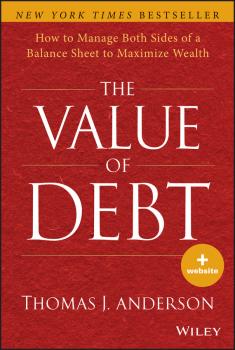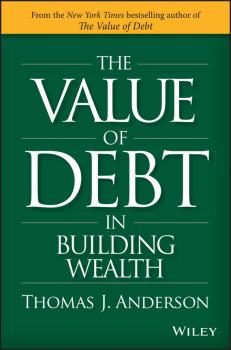ТОП просматриваемых книг сайта:
Thomas Anderson J.
Список книг автора Thomas Anderson J.The Value of Debt. How to Manage Both Sides of a Balance Sheet to Maximize Wealth - Thomas Anderson J.
Аннотация
A New York Times bestseller and one of the Ten Best Business Books of 2013 by WealthManagement.com, this book brings a new vision of the value of debt in the management of individual and family wealth In this groundbreaking book, author Tom Anderson argues that, despite the reflex aversion most people have to debt—an aversion that is vociferously preached by most personal finance authors—wealthy individuals and families, as well as their financial advisors, have everything to gain and nothing to lose by learning to think holistically about debt. Anderson explains why, if strategically deployed, debt can be of enormous long-term benefit in the management of individual and family wealth. More importantly, he schools you in time-tested strategies for using debt to steadily build wealth, to generate tax-efficient retirement income, to provide a reliable source of funds in times of crisis and financial setback, and more. Takes a «strategic debt» approach to personal wealth management, emphasizing the need to appreciate the value of «indebted strengths» and for acquiring the tools needed to take advantage of those strengths Addresses how to determine your optimal debt ratio, or your debt «sweet spot» A companion website contains a proprietary tool for calculating your own optimal debt ratio, which enables you to develop a personal wealth balance sheet Offering a bold new vision of debt as a strategic asset in the management of individual and family wealth, The Value of Debt is an important resource for financial advisors, wealthy families, family offices, and professional investors.
Аннотация
The book of financial wisdom that your future self will thank you for reading For many adults under 40, 'debt' is a four-letter word—something that should be avoided but is all too often unavoidable. In The Value of Debt in Building Wealth, bestselling author Thomas J. Anderson encourages you to rethink that. You'll walk away from this book with an understanding of how you can use debt wisely to secure the financial future you envision for yourself and your family. Student loans, mortgages, lines of credit, and other forms of debt are all discussed in detail, with a focus on smart planning for those who are accumulating assets—and debt—now. Should you rent or buy? How important is liquidity? What is good versus bad debt? How much debt should you have? What debt-to-income and debt-to-asset ratios should you aim for? Fixed debt or floating debt? What's the best way of saving for college and retirement? These are big questions that deserve thorough answers because the choices you make now could influence the course of your life. This thought-provoking book will open your eyes to savvy financial strategies for achieving your goals faster and with healthier bank accounts. Explore strategies for smart debt management, explained by one of the nation's top financial advisors Gain an understanding of investment basics and key financial concepts you'll need to achieve your long-term goals Understand the risks of having debt and the potential risks of being debt-free Make financial decisions now that will maximize your wealth, freedom, and opportunity later This book is not about buying things you cannot afford. It is about liquidity, flexibility and optimizing your personal balance sheet. The Value of Debt in Building Wealth is full of ideas you can apply to your own situation—no matter what your current asset level. Read this book today and thank yourself later.
Аннотация
Increase the odds you won't run out of money in retirement – using debt! Conventional wisdom is wrong – being debt free in retirement may actually increase your risk. The Value of Debt in Retirement teaches you how incorporating debt into your retirement strategy may increase your return, lower your taxes and actually lower your risk. You read that right. If handled correctly, debt—that thing we've all been taught to avoid—can play an integral role in your life, especially in retirement. New York Times Best Selling Author and nationally acclaimed financial expert Tom Anderson shows you how to use the time tested strategies of the best companies and the ultra rich to retire comfortably, minimize taxes, buy the things you have always wanted to have and do the things you have always wanted to do. Thought provoking and against the grain, Anderson explains why your risk tolerance doesn't matter, why being debt free may actually increase your risk and why rushing to pay off your mortgage may be a financial disaster. Full of shocking revelations and tricks high- net-worth individuals have used for years, The Value of Debt in Retirement opens the world to a new approach to wealth management in retirement, one that factors in both sides of the balance sheet as an integrated ecosystem. Real-world case studies illustrate how informed debt strategies can lead to a happier, healthier retirement. See how an individual with a net worth of more than $5 million can spend $20,000 per month – after taxes – and pay less than $5,000 per year in taxes, how it is possible to increase your rate of return by 50%, and how a lower risk portfolio with debt could increase the chances you do not run out of money. Specifically written to Baby Boomers, practical guides and checklists show how to use debt strategies to fund primary and secondary properties, refinance credit card debt, and finance hobbies, such as cars and boats and recreational vehicles. Additional guides show how you can help your children, help your parents and leave a bigger legacy for your heirs and favorite charities. Regardless of your net worth, The Value of Debt in Retirement provides tools to use to apply these concepts to your personal situation. There is no free lunch: the book delivers a balanced perspective focusing on the potential risks and benefits of the strategies discussed. A discussion on economic history highlights some of the shocks the economy may face and provides important warnings that you should factor into your retirement plan. Anderson not only shows that your life expectancy may be longer than you think, but also illustrates that many investors may be on track to average returns well under 4% for the next ten years – a potentially devastating combination. Irrespective of your beliefs about debt, The Value of Debt in Retirement proves risk is more important than return for retirees and provides suggestions on ways to minimize that risk. Not all debt is good and high levels of debt are bad. The Value of Debt in Retirement is about choosing the right debt, in the right amounts, at the right time. Perhaps most importantly, this book isn't for everybody. This book requires responsible actions. If you can't handle the responsibility associated with the ideas then this book then it isn't for you. If you need a rate of return under 3% from your investments then you may not need this book. But if you can handle the responsibility and if you need a return above 3%, this book may offer insights into the best (and potentially only) way to achieve your goals.



